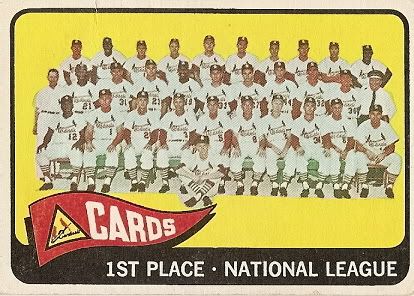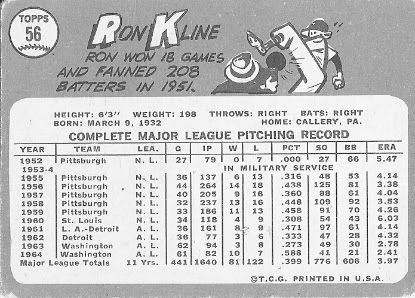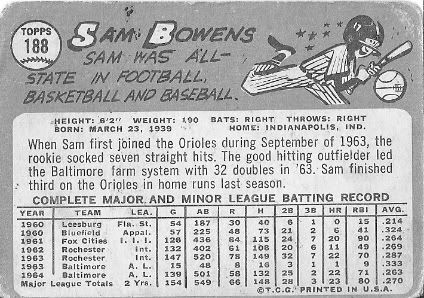
The Cardinals won the whole ball of wax in 1964, besting an end-of-an-era Yankee team in a back-and-forth seven-game World Series. In the regular season, they had the same 93-69 record that they had compiled the previous season. Whereas they finished six games behind the Dodgers in 1963, the Redbirds managed to eke out the National League pennant by a single game over both the Reds and Phillies the following year. The Giants (three games) and Braves (five games) also finished within striking distance in a thrilling pennant race. St. Louis scored 715 runs (second-best in the N.L.), and allowed 652 (fourth-worst), and outplayed their run differential by five wins. 1,143,294 fans piled into Sportsman's Park in 81 home games, placing their attendance squarely in the middle of the league.
How did the Cards outscore their peers? They topped the senior circuit with a .272 average, and their .324 on-base percentage and .392 slugging mark were #2. Lou Brock provided an unexpected spark, hitting .348 with 33 steals after a midseason trade from the Cubs. Curt Flood (.311) was also a table-setter at the top of the order. Third baseman and N.L. MVP Ken Boyer (.295, 24 HR, 119 RBI) and first baseman Bill White (.303, 21 HR, 102 RBI) were the big run producers. Boyer, Flood, White, and shortstop Dick Groat (.295, 35 doubles) were All-Stars. Last but not least, catcher Tim McCarver (.288, 9 HR, 52 RBI) packed a pretty good bat for a backstop.
While the pitching hung near the back of the pack in total runs allowed, a 3.43 ERA is no small potatoes. Future Hall of Famer Bob Gibson (19-12, 3.01 ERA, 285 K) was starting to hit his stride, reaching new career highs in wins, complete games, and strikeouts. 35-year-old Curt Simmons, discarded by the Phillies a few years earlier, came back to haunt them (18-9, 3.43). Young Ray Sadecki (20-11, 3.68) led the club in wins. Journeyman Barney Schultz (1.64 ERA, 14 saves) was invaluable in relief down the stretch.
After hovering around .500 in their first two seasons under Red Schoendienst, the Cardinals returned to the World Series in both 1967 and 1968, beating the Red Sox in the former and bowing to the Tigers in the latter. St. Louis wouldn't return to the postseason afterward until 1982, when Whitey Herzog's team won its only world title in the first of an eventual three 1980's trips to the Fall Classic.
























